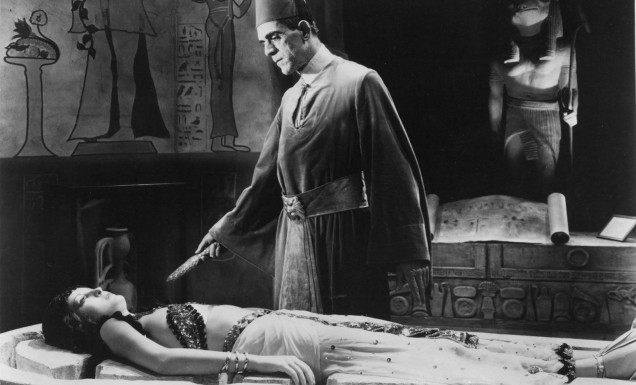The Mummy
horror, USA, 1932
DIRECTED BY: Karl Freund

CAST:
Boris Karloff (Imhotep),
Zita Johann (Helen Grosvenor),
David Manners (Frank Whemple),
Arthur Byron (Sir Joseph Whemple),
Edward Van Sloan (Doctor Muller),
Bramwell Fletcher (Ralph Norton),
Noble Johnson (The Nubian),
Kathryn Byron (Frau Muller),
Leonard Mudie (Professor Pearson),
James Crane (The Pharoh)
SCRIPT:
John L. Balderston
PHOTOGRAPHY:
Charles Stumar
MUSIC:
James Dietrich
EDITING:
Milton Carruth
COSTUMES:
Vera West
Synopsis:
In 1921, an expedition of the prestigious British Museum led by Sir Joseph Whemple found a well-preserved mummy in Egypt. Their satisfaction is only slightly spoiled by the revelations of Whemple's close associate Dr. Muller that the deceased was embalmed and buried in an unconventional manner, and that a curse was placed on his coffin. When left alone with the coffin containing the mummy, Sir Joseph's enthusiastic young assistant Ralph Norton breaks it open on his own initiative, finds the ancient scroll of Thoth inside and begins to read it, which unexpectedly causes the mummy to awaken. And when the other members of the expedition return, they will find that the mummy is gone and that Ralph is terrified and catatonic.
Eleven years later, the British Museum will send a new expedition to Egypt, led by Frank Whemple, son of Sir Joseph. At the initiative of the eccentric Egyptian historian Ardath Bey, they will go in search of the tomb of Princess Anck-es-en-amon, not knowing that the sinister Bey is manipulating them and has his own plans.
He is actually the reincarnation of the cursed high priest Im-ho-tep, whose mummy disappeared after the expedition's discovery a decade earlier. After sneaking into a museum in Cairo and stealing the mummy of Anck-es-en-amon, which had been found in the meantime, Bey will begin a ritual to reincarnate the spirit of the late princess in the body of young Helen Grosvenor, the daughter of a British governor with whom Frank is deeply in love.
The fantastic horror The Mummy, directed by Karl Freund, is one of the first works from the so-called of the 'golden period of horror', which was mostly created under the auspices of the Universal Studios production company between 1931 and 1941.
At the time of the premiere, the title character of the mummy immediately gained cult status, and is still one of the key figures in the pantheon of the so-called. Universal's monsters, along with Dracula, Frankenstein's monster, Dr. Jekyll / Mr. Hyde and the Werewolf.
Freund was born in the Czech Republic and grew up in Berlin, and before emigrating to the USA in 1929, he gained a reputation as the most important German cinematographer, among other things, filming newsreels for the Pathé company and collaborating with such great directors as F.W. Murnau (The Last Man) , Fritz Lang (Metropolis) and Walter Ruttmann (Berlin - symphony of the metropolis), but also Robert Wiene, Ernst Lubitsch, Carl Theodor Dreyer and others, as well as with the actress Asta Nielsen.
After arriving in the USA, unsigned, he filmed the most successful screen adaptation of the novel Nothing in the West directed by Lewis Milestone, so that his dynamic camera would find its natural niche in the horror genre, which he enriched first as a cinematographer and then as a director. After joining forces with the director Tod Browning in 1931 on the film Dracula, in which he did not only the camera work but also the director's work, the following year he made his debut as a director in Hollywood, precisely with the film The Mummy, which came as the crowning glory of his short directorial projects that realized in Germany. In addition to screenwriter John L. Balderston, story authors Richard Schayer and especially Nina Wilcox Putnam, who wrote the nine-page story Cagliostro, in which she took the character of a hypnotist similar to Svengali, are extremely important for the film's success.
Schayer liked that story very much, and he first developed it, and Balderston finally shaped it into a concrete scenario. In this, he mostly relied on the motif of the mummy's curse, which had its origin in the sensationalist writings about King Tut's tomb, which were abundant in the American and European media in those years after the discovery of Tutankhamun's tomb in 1922.
The events in the film are reminiscent to a good extent of those from the aforementioned Dracula, which is not surprising since it was a big hit, and apart from some similarities or variations in the plot, there is also a cast that again includes David Manners and Edward Van Sloan.
Although in some segments today it may seem outdated and anachronistic, The Mummy is still mostly an impressive film characterized by a slower pace of narration and an emphasis on the psychologization of the characters. There are few explicit shocking scenes, and the most attention is devoted to the suggestive gradation of the anxious atmosphere with Egyptian esotericism as a threat in the background.
Boris Karloff is, as expected, great, with an appearance thanks to master of masks Jack P. Pierce, and a screeching deathly voice, and his close-up shots by cinematographer Charles J. Stumar, presumably at Freund's request, are shaped to emphasize an ominously glowing gaze. According to Karloff, filming The Mummy was the most difficult in his career, mostly due to the need to constantly wear an extremely complex and even painful mask and make-up.
Unlike similar Universal hits, this one did not receive an immediate sequel, although in 1940 a partial remake of The Mummy's Hand directed by Christy Cabanne was filmed.
Text author: Josip Grozdanić
b/w, 73'